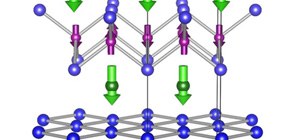
Discovery of a magnet capable of controlling Dirac fermions with zero mass
Innovation in application to super-fast spintronics
A group of researchers from Osaka University and The University of Tokyo succeeded in synthesizing two-dimensional layers of bismuth (Bi) with Dirac electrons and magnetic multilayer blocks of europium.
Graduate School of Science, Osaka University -- SAKAI Hideaki (Associate Professor)
Graduate School of Engineering, The University of Tokyo -- ISHIWATA Shintaro (Associate Professor), MASUDA Hidetoshi (Graduate Student)
Using flux growth in a high vacuum, this group succeeded in the synthesis of EuMnBi2, a layered substance of high-quality single crystal which is thought to have both properties of Dirac fermions and magnets. This substance features hybrid architecture consisting of two-dimensional layers of Bi with Dirac electrons and europium with magnetic properties.
In order to verify the strong correlation between Dirac fermions and the magnetic state, this group measured electric resistance in a strong magnetic field (some 30-60 tesla) at The Institute for Solid State Physics of The University of Tokyo and the High Field Laboratory for Superconducting Materials of Tohoku University.
Furthermore, in order to elucidate the magnetic state, this group conducted magnetic scattering experiments of radiated x-rays at the Photon Factory of The Institute of Materials Structure Science, High Energy Accelerator Research Organization.
As a result, they found that electric resistance significantly changed according to the magnetic order of europium. It was also found that when a magnetic field was applied perpendicularly to the surface and the direction of magnetic moment was rotated by 90 degrees, the conductivity perpendicular to the surface was suppressed by 10 percent and Dirac fermions were confined within the surface.
Furthermore, by confining Dirac electrons in the two-dimensional layer of Bi, or the superconducting layer, through the use of this effect, this joint group achieved a bulk half-integer quantum Hall effect, in which the value of the Hall resistance becomes discrete, in a bulk magnet of Dirac fermions for the first time.
This group’s achievement will develop a new field of study, strong correlated quantum conductance of Dirac electrons, and become an innovation in realizing super high speed spintronics, the foundation of high-speed and energy-saving electronics.
Abstract
For the innovation of spintronic technologies, Dirac materials, in which low-energy excitation is described as relativistic Dirac fermions, are one of the most promising systems because of the fascinating magnetotransport associated with extremely high mobility. To incorporate Dirac fermions into spintronic applications, their quantum transport phenomena are desired to be manipulated to a large extent by magnetic order in a solid. We report a bulk half-integer quantum Hall effect in a layered antiferromagnet EuMnBi 2 , in which field-controllable Eu magnetic order significantly suppresses the interlayer coupling between the Bi layers with Dirac fermions. In addition to the high mobility of more than 10,000 cm 2 /V s, Landau level splittings presumably due to the lifting of spin and valley degeneracy are noticeable even in a bulk magnet. These results will pave a route to the engineering of magnetically functionalized Dirac materials.

(A to D) Temperature dependence of magnetic and transport properties near the AFM transition temperature (TN) for EuMnBi2. (A) Magnetic susceptibility M/H for the field parallel to the c axis (H||c) at 0.1 T (blue) and 7 T (red). Open symbols are the data for the field perpendicular to the c axis (H⊥c) at 0.1 T. (B) Intensity of resonant magnetic reflection (0 0 11) at 6.975 keV at 0 T. The inset shows the profile of the (0 0 11) reflection along [001] at 6.975 keV (resonant) and 7.00 keV (nonresonant). In-plane resistivity ρxx (C) and interlayer resistivity ρzz (D) at 0 and 9 T (H||c). Schematic sample configuration for the resistivity measurement is shown in each panel. emu/mol, electromagnetic unit per mole; a.u., arbitrary unit. (E) Schematic illustration of the plausible magnetic structure for EuMnBi2 at zero field, together with the formal valence of each ion. The arrangement of the Mn sublattice is assumed to be the same as in SrMnBi2 (45). (F) Magnetic phase diagram for the Eu sublattice as functions of field (H||c) and temperature. PM and AFM denote the paramagnetic and antiferromagnetic states, respectively. Hf and Hc correspond to the transition fields to the spin-flop AFM and PM (forced ferromagnetic) phases, respectively. Black arrows are schematic illustration of the Eu moments sandwiching the Bi− layer. Note the Mn sublattice orders at ~315 K (>TN).
To learn more about this research, please view the full research report entitled " Quantum Hall effect in a bulk antiferromagnet EuMnBi2 with magnetically confined two-dimensional Dirac fermions " at this page of the Science Advances website.
Related link
- Hanasaki Lab., Graduate School of Science, Osaka University (link in Japanese)
- EurekAlert!
- AlphaGalileo
